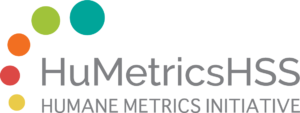The world has changed dramatically since the HuMetricsHSS initiative began its work. In particular, the systemic inequities that were already obvious to many have come to the fore in the last year with the COVID-19 pandemic and the Black Lives Matter protests. Within the academy, hierarchical inequities that undervalue teaching — the centrality of which to the academic endeavor is now undeniably evident — have become more obvious, as have issues of social precarity among student populations, many of whom are now grappling not only with increased debt or financial burdens but also with the challenges of studying and learning in home environments that may not be safe or supportive for them. [ref]
For a sampling of the unsafe and precarious conditions faced by many college students during COVID-19, see, e.g.,
Brown, Sandra. 2020. “Covid-19 Sent LGBTQ Students Back to Unsupportive Homes. That Raises the Risk They Won’t Return.” The Chronicle of Higher Education, 24 April. https://www.chronicle.com/article/covid-19-sent-lgbtq-students-back-to-unsupportive-homes-that-raises-the-risk-they-wont-return/
Li, Ellen. 2020. “‘Anything to Not Go Home’: Forced Out by COVID-19, Some Students Face Unsafe Conditions.” The Daily Princetonian, 4 April.
Marston, Anna. 2020. “Abusive Homes and COVID-19.” Mental Health America of Virginia Blog, 28 May. https://mhav.org/abusive-homes-and-covid-19/
Stauffer, Rainesford. 2021. “The Housing Crisis for Students Was Bad Before COVID — and It’s Only Getting Worse.” Apartment Therapy (blog), 15 January. https://www.apartmenttherapy.com/college-student-housing-crisis-covid-36865268
Svrluga, Susan. 2020. “For Some Students in Need, Campus Is a Safe — but Lonely — Place to Live during the Pandemic.” The Washington Post, 29 December. https://www.washingtonpost.com/education/2020/12/29/college-students-dorms-life-pandemic/[/ref] Similar levels of precarity, driven by the economic uncertainties of tuition-driven revenue, are keenly felt by adjuncts, contingent faculty, and hourly waged staff, many of whom are recent graduate students who may carry considerable debt load. As we have learned through discussions with faculty and administrators in our workshops and through research interviews conducted over the last year, inequalities and inequities appear to be growing rather than shrinking, and faculty, staff, and administrators are urgently searching for values-enacted evaluation frameworks that enable them to reshape the culture of higher education so that the academy is more humane, supportive, open, and just.
While some faculty and administrators have admitted to us their longing to return to the status quo and a semblance of “normalcy” found within the traditional classroom and research environment, fully embracing the comfort While some faculty and administrators have admitted to us their longing to return to the status quo and a semblance of “normalcy” found within the traditional classroom and research environment, fully embracing the comfort such routine brings, many more have expressed their feeling that the time is ripe to address head-on the systemic changes we have long known are needed. Generally, there is a sense that we stand at an inflection point of transformative change in higher education, an appreciation of the action-oriented examples the HuMetricsHSS initiative offers, and an enthusiasm for being engaged with enacting this change.
One key finding from our research across the BTAA is that while academic institutions issue multiple values statements, those statements often do not affect the practice of scholarship nor meaningfully connect to the incentive structures in place to advance faculty, staff, and administration. Key examples from our research include assertions by universities of stronger commitments to diversity, equity, and inclusion and stronger encouragement of publicly engaged scholarship. In our discussions with deans, vice provosts for faculty affairs, DEI officers, department chairs, faculty from all ranks, and librarians across the BTAA, we have uncovered a combination of hope in and commitment to pursuing these stated values alongside a recognized failure in how incentive structures measure and reward this work.
Providing meaningful pathways to align stated values to a process that recognizes and rewards the fulfillment of those values remains the key goal of the HuMetricsHSS initiative. From the conversations fostered through our research work and our workshops, we know that our discussants welcome the values-enacted HuMetricsHSS approach because it provides a vocabulary and framework to strengthen arguments for rewarding the work that actually reflects their stated values. All too often labor around public engagement, around diversity, equity, and inclusion, around open access, around mentoring, and around other kinds of work crucial to the thriving of the academic enterprise is seen as “additive” to a traditional set of responsibilities and activities that are easily measured (often via bibliometrics) and that consequently count most in promotion and tenure review — or, in the case of an increasingly contingent academy, for continued employment — rather than, as we and they believe, this work being central to scholarship of the highest quality and most urgent relevance.
We’re wrapping up this period of research and incubation, and we’re very excited to announce what we’re up to next, but first, in case you’ve missed them:
- Our article, The Transformative Power of Values-Enacted Scholarship, was published in Nature and expands more on our philosophy and argument for rethinking the academy from the ground up;
- Our new (beta-version) Values-Sorter tool allows you to consider how values you care about might manifest in different kinds of academic work;
- Two sections of our Workshop Guide are now live and downloadable so you can run your own team/department through our process and card-sorting exercises;
- Our Zotero library is reorganized and newly tagged for ease of access, and contains thousands of relevant titles.
More soon,
The HuMetricsHSS Team
